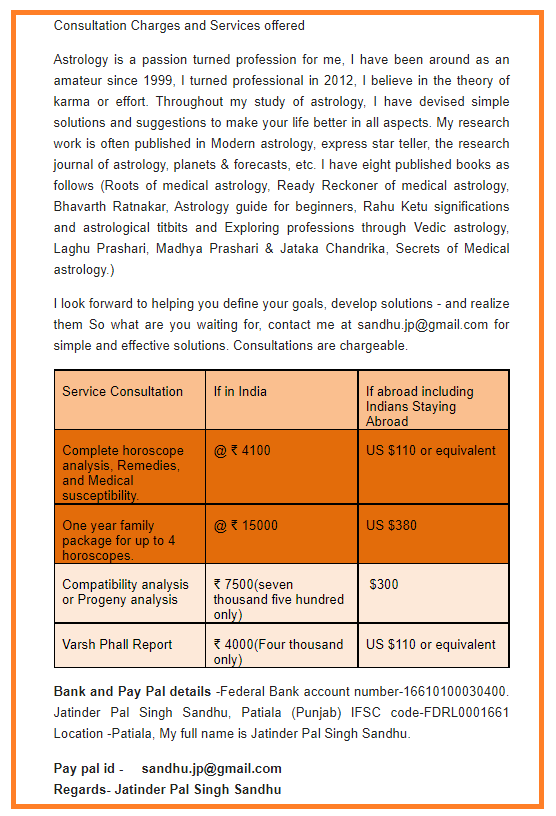Astronomy as Relevant to Astrology The Vedic System of Calculating the Ascendant The most important point in the construction of a horoscope is the Ascendant. The ascendant is the point of cutting of the ecliptic by the eastern horizon of a place. The earth spinning on its axis in a linear movement takes 24 hours to complete one rotation. But what exactly is the duration of a day? There are many types of days prevalent. Sidereal day: The time taken by earth to spin one complete rotation of 360 degrees on its axis. Average duration of one sidereal day is 23 hrs, 56 min, 4.091 sec. Savana day: The duration of time between one sunrise to another sunrise is a Savana day. For people living in northern hemisphere, from winter solstice day onwards, the sunshine hours (dinamana) increases and night hours (ratrimana) decreases. As the sunrise every day is earlier than the previous day, the duration of the savana day is less than 24 hours till the Sun reaches its maximum declination at summer solstice. After that the dinamana reduces and the ratrimana increases. Since the sunrise of every day is later than the previous day, the duration of the savana day is more than 24 hours till it reaches the winter solstice again. Mean Solar Day: The average of all the days of a year. It’s duration is equal to 24 hours. The Vedic system recognises a day as the duration of time from one sunrise to the next sunrise. This span, known as a Savana day, is measured in units of ghatis. One Savana day is equal to 60 ghatis and each ghati is divisible into 60 palas or vighatis. The earth continuously spins on its axis in a west to east direction. For a person situated on the surface of the earth, different signs of the zodiac appear to rise in the eastern horizon and set in the western horizon. With the completion of one rotation of the earth, all the twelve signs of the zodiac rise and set during one sidereal day. Rashimana (Oblique Ascension) Rashimana is the rising periods of signs of the zodiac. As there are twelve equally divided signs of the zodiac and it takes approximately 24 hours for all the signs to rise, therefore, one sign should take about two hours to rise in the eastern horizon. But it’s not so. As the plane of the ecliptic is inclined at an angle of 23.5 degrees to the plane of the celestial equator, the rising time of different signs is not uniform. The time taken by different groups of signs at the equator is given in Table 1.
Rashimana values are calculated for Sayana signs and are measured in units of Asus. One unit of Asu is equivalent to 4 seconds of sidereal time. Rashimana values vary from one latitude to another. These values once calculated for any place do not change from year to year. Charakhandas (Ascensional Differences) Variations in the rising of different signs at different latitudes can be calculated with the help of Charakhandas or ascensional differences for those latitudes. To know the Charakhandas of a particular place with the help of ‘Hindu Dial’, measure the length of the mid-day shadow, on the day of the equinox, of a shanku of 12 units length (please refer to Astrology Primer # 5, Vol.1, No.5). Put this figure at three places and multiply the first figure with 10; second with 8 and; third with 10 divided by 3. This gives the Charakhandas for I, II, and III groups of signs respectively. These Charakhanda values are in palas or vighaties. To convert these values to asus, multiply the charakhandas by six. Signs of Long Ascension and Short Ascension For people living in the northern hemisphere of the earth, on the day of winter solstice, when the Sun is at zero degrees Sayana Capricorn, the sunshine hours are the shortest. With the rising of the Sun, sign Capricorn rises in the eastern horizon followed by other signs in sequence. At the time of sunset, the point rising at the eastern horizon would be 180° opposite the Sun’s longitude (thus zero degrees Cancer). Therefore, during the daytime signs Capricorn to Gemini rise in the shortest duration of time, while at night the signs Cancer to Sagittarius take the longest duration of time.
When the Sun is at summer solstice (zero degrees Sayana Cancer) during the daytime signs Cancer to Sagittarius spend the longest duration of time to rise and during night signs Capricorn to Gemini take the shortest duration of time. Sign which takes longer time in rising than the time taken by same sign at the equator, is the sign of long ascension and the sign which takes shorter time in rising is the sign of short ascension. Signs Capricorn to Gemini are short ascension signs while Cancer to Sagittarius are long ascension signs for norther latitudes. Reverse is the case for people living in the southern latitudes. As the latitude of the observer increases, the duration of signs of long ascension become much longer while the duration of signs of short ascension become much shorter. Calculation of rising times of different signs (Rashimana) for a particular place After knowing the Charakhandas of a particular place, we can calculate the rashimana of different signs. Add the Charakanda values, in asus, to the rashimana values at the equator in their respective groups for signs of long ascension and subtract the Charakhandas from their respective groups for signs of short ascension. Correlation of the earth with the Zodiac Calculation of ascendant for any given moment is an effort to establish a relationship between the horizon of the observer on the earth with the zodiac. The earth is spinning continuously on its axis. To an observer, being located on the surface of the earth, it appears that the earth is stationary and the sky with all the stars and heavenly bodies is drifting towards the west after rising in the east. To establish a relationship of the earth with the zodiac, we have to refer to some identifiable point on the zodiac. The rising, setting or the meridian passage of this point is to be observed to find out the actual position of this point at any given moment of time for the place of location of the observer. Once we know the position of one point of the zodiac, we can relate the other points of the zodiac with respect to this identifiable point. This identifiable point could be a star or a planet or the vernal equinox (zero degrees Sayana Aries point) of the zodiac. When we observe the passing of the Vernal Equinox on the meridian of a place, it is zero hours Sidereal time for that place. Sidereal time at any given moment indicates the time elapsed since the vernal equinox crossed the meridian of that place. The Indian system makes use of the position of the Sun in the zodiac to establish a link between the earth and the zodiac. At the time of sunrise, the centre of the Sun is touching the eastern horizon. Sunrise is considered to be the beginning to the day and that day remains in force till the next sunrise. The duration of this day is considered to be equal to sixty ghatis. One ghati is roughly equal to 24 minues of time. The longitude of the Sun is identical with the cusp of the sign rising at the time of sunrise. A track of the number of ghatis and palas passed since sunrise is kept and is called Ishtakaala. Since the rashimana values are for Sayana signs, the longitude of the Sun is also considered in Sayana values. Inputs to calculate the Ascendant In order to calculate the cusp of the ascendant, we need the following: 1. The time of sunrise at the required place on the relevant day. 2. The Sayana position of the Sun at the time of sunrise at the place in question. In case the available ephe-meris provides the nirayana position of the Sun, the Sayana position may be obtained by adding to it the appropriate ayanamsha. 3. The ishtakala or the duration of time elapsed from the time of sunrise. 4. Rashimana or the duration of the rising of different signs at the particular latitude of the place. Steps to Calculate the Ascendant The following steps describe the method of calculation of the ascendant for a given place at a given date and time. For example, let’s calculate the ascendant rising at Gurdaspur, India (latitude 32°N02' longitude 75°E31') on April 1, 1997 at 12.00 hours IST. Step 1. Calculate the Charakhandas On the ‘Hindu Dial’, measure the length of the mid-day shadow, on the day of the equinox, of a shanku of 12 units length.
The length of the shadow at Gurdaspur (32 degrees latitude) from the above table is 7.5. Now multiply this figure with 10, 8, and 10/3 respectively to get the Charakhanda values in palas or vighatis.
Multiply each with 6 to convert the values in asus.
The derived values of 450, 360 and 150 are the charakhandas for I, II and III groups of signs respectively. Step 2. Calculate the Rashimana The Rashimana for different groups of signs at the equator are:
To the above rashimanas we apply the Charakhanda corrections as worked out above to obtain the rashimana for different signs at the latitude in question. Add the Charakandas to their respective groups for signs of long ascension and subtract the Charakhandas from their respective groups for signs of short ascension.
Step 3. Find out the Sunrise time From the ephemeris, calculate the sunrise time on the given date for the place of birth. For Gurdaspur the sunrise time is 6h:20m:40s (IST). Step 4. Find out the Sayana Sun Again from the ephemeris, calculate the position of Sayan Sun at the time of sunrise. If the available ephemeris provides the longitudes of planets in nirayana values, add the ayanamsha to the Sun’s longitude to get the Sayana value. The nirayana longitude of the sun at the time of sunrise on April 1, 1997 is 11s17°31'16". Adding to this the ayanamsha value on the given date, i.e., 23°49'06", we get the Sayana longitude of the Sun at the time of sunrise as 0s11°20'22". This also indicates the longitude of the ascendant at the time of sunrise. Step 5. Find out the Ishtakala Ishtakala is the time elapsed since the time of sunrise to the time of birth. Traditionally the time of birth is recorded in ishtakala only. Since in our example the time of birth is in hours-minutes, etc., it can be converted to ishtakala by subtracting the time of sunrise from the time of birth. Time of birth : 12h:00m:00s Sunrise time : 06h:20m:40s Ishtakala in hrs. : 05h:39m:20s Step 6. Cusp of the Ascendant From Step 4 above, we know the sign that the sun is in at sunrise and, therefore, the cusp of the sign rising at the time of sunrise. The duration of this sign being known (Step 2), it is possible to work out how much of this sign has yet to rise above horizon and how much time it will take to do so.
After 50m:45s of sunrise (i.e. from 7h:11m:25s onwards), the sign Taurus will start and last for 1h:35m:40s (i.e., upto 8h:47m:05s). The next sign Gemini (with a duration of 1h:58m:44s) lasts until 10h:45m:49s. Cancer (duration of 2h:18m:44s) lasts until 13h:04m:33s which includes our time of birth (12 noon). Thus we have Cancer rising at 12 noon.
Thus we get the cusp of ascendant at 12 noon as Cancer 16°02'30". This is the Sayana value. Reduce the ayanamsha from this value to obtain the cusp of the ascendant in nirayana value. Thus the nirayana ascendant would be: 3s16°02'30" – 23°49'06" = 2s22°13'24" or Gemini rising at 22°13'24". | |||||||||||||||||||||||||||||||||||||||||||||||||||||||||||||||||||||||||||||||||||||||||||||||||||||||||||||||||||||||||||||||||||||||||||||||||||||||||||||||||||||||||||||||||||||||||||||||||||||||||||||||||||||||||||||||||||||||||||||||||||||||||||||||||||||||||||||||||||
Search This Blog
Consultation Charges

Services and Charges
